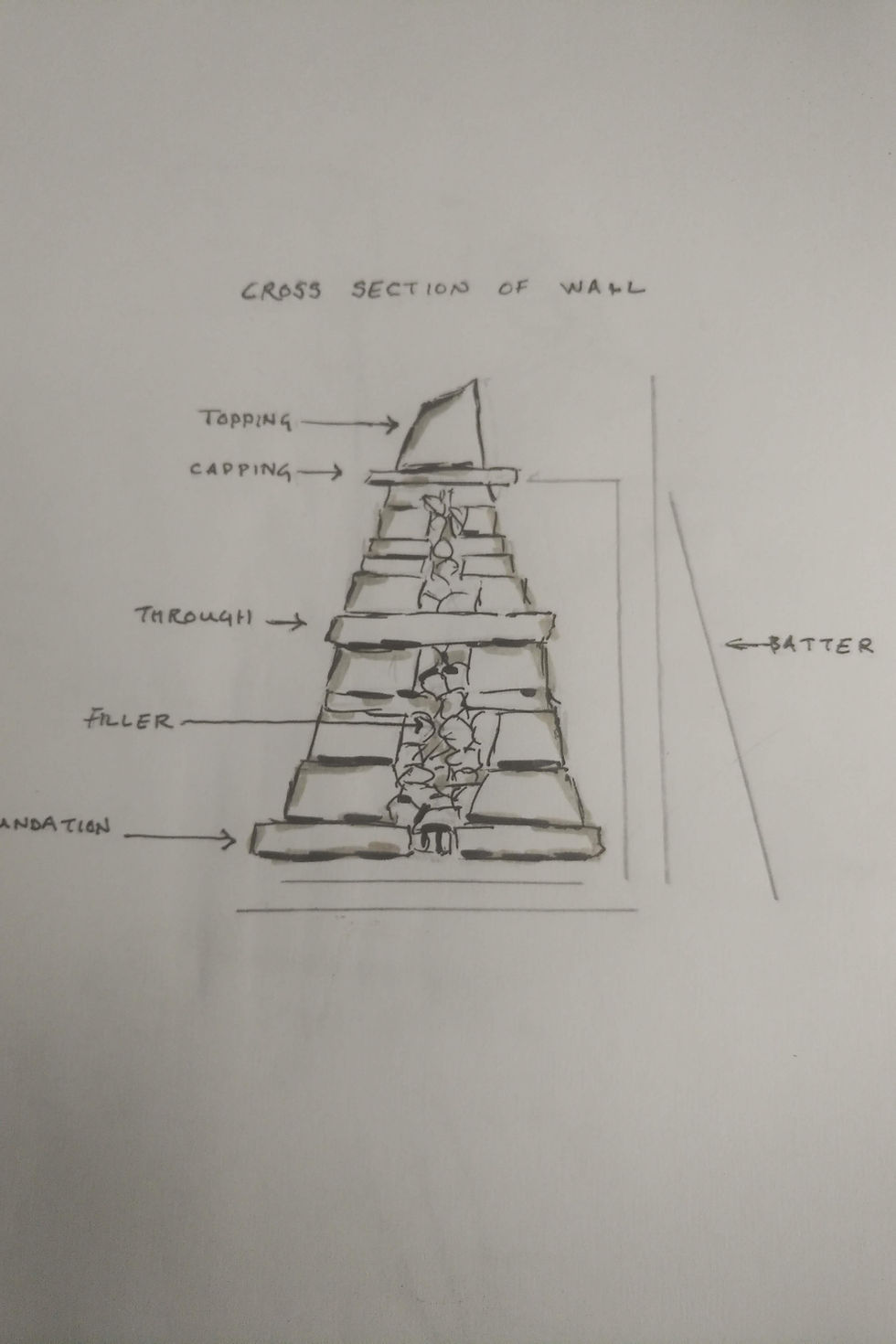Dry Stone Wall Angles and Batter
- kieran
- May 23, 2023
- 4 min read
The correct angle for a dry stone wall, also known as the batter angle, can vary depending on regional traditions, specific wall design, and local conditions. However, a commonly recommended batter angle for dry stone walls is between 5 to 10 degrees.
I usually follow a angle of 1:6. So for every 6 inch I gain in height of my wall, the wall comes in 1 inch.

An angle of 1 to 6, also expressed as 1:6 or 1/6, represents a slope where for every 1 unit of horizontal distance, the vertical rise is 1/6 of that distance.
To calculate the angle in degrees, you can use the inverse tangent (arctan) function. In this case, the arctan of 1/6 is approximately 9.47 degrees.
So, an angle of 1 to 6 corresponds to approximately 9.47 degrees.
The batter angle refers to the slope or lean of the wall, where the wall gradually leans backward as it goes higher. This helps to provide stability and strength to the structure. The purpose of the batter is to distribute the weight of the stones and provide resistance against forces such as gravity and lateral pressure. The specific batter angle chosen may also depend on factors such as the type of stone being used, the height of the wall, and the desired appearance. In some cases, steeper batter angles may be used for taller walls or areas with increased stability requirements. It's important to note that the construction of dry stone walls often requires skill and expertise. If you are planning to build a dry stone wall, it is recommended to consult with experienced professionals or refer to local guidelines and regulations to ensure proper construction techniques are followed.
If I was to build a wall without an angle, I would have several issues.
Lack of Stability: Without a batter angle, the wall may be more prone to leaning or collapsing under its own weight or external pressures. The sloping angle helps distribute the weight of the stones and provides stability against gravity and other forces.
Structural Weakness: A straight vertical wall lacks the inherent strength and resilience that a properly constructed dry stone wall with a batter angle possesses. The batter angle helps create interlocking and self-supporting layers of stones, enhancing the structural integrity of the wall.
Reduced Resistance to Pressure: The lack of a batter angle makes the wall more susceptible to lateral pressure, such as from soil or water against the wall. This can cause the wall to bulge or fail under the pressure.
Limited Drainage: A vertical wall may impede proper drainage of water, leading to increased water accumulation behind the wall. This can result in increased pressure on the wall and potential damage over time.
Aesthetic Considerations: Dry stone walls are often built with a batter angle for both functional and aesthetic reasons. The batter angle helps create visually appealing and harmonious lines that blend well with the surrounding landscape. A straight wall may appear less visually pleasing and out of place in certain settings.
It is important to follow proper construction techniques and guidelines when building dry stone walls to ensure their stability, durability, and aesthetic appeal. Consulting with experienced professionals or learning from reputable sources can provide valuable insights into the correct construction methods for dry stone walls. I use a batter frame when building a wall. A batter board is a temporary framework or structure used in construction to establish the precise layout and dimensions of a building or structure. It is commonly used during the initial stages of construction to define the corners, lines, and elevations of the project. Here's how a batter board is typically used: Batter boards are usually set up at the corners of the building site. They consist of wooden stakes or posts driven into the ground at each corner, with a horizontal board (often called a crosspiece or ledger) attached to the top of the stakes. The stakes are securely anchored into the ground to provide stability.
Establishing Reference Points: String lines or plumb bobs are attached to the crosspieces, running along the desired alignment and elevation points of the building. These lines establish the outer boundaries and reference points for the construction project.
Aligning and Leveling: Builders use the batter boards to ensure that the string lines are perfectly aligned and level. This helps ensure that the foundation, walls, and other components of the building are correctly positioned and aligned according to the construction plans.
Measurement and Layout: With the batter boards in place, builders can accurately measure distances and angles from the established reference points. They can use these measurements to mark out the layout of the building, including the position of walls, corners, and other structural elements.
Guiding Construction: Throughout the construction process, the batter boards and string lines serve as a guide for the builders. They can refer to the lines to verify the accuracy of their work and ensure that the structure is being built according to the intended design.
Once the construction progresses, the batter boards are typically removed, as they are no longer needed once the layout and reference points have been established. However, they play a crucial role in ensuring accurate and precise construction during the early stages of a building project.


Comments